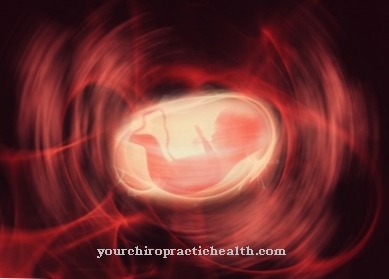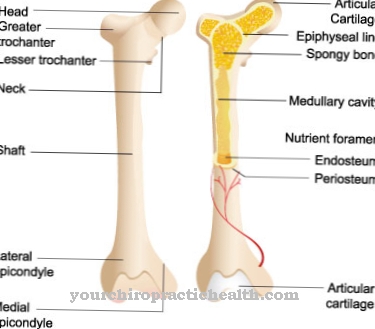Under a Elevated diaphragm Doctors understand a change in the position of the diaphragm. It curves upwards towards the thorax. The causes of an elevated diaphragm can vary and do not always require medical treatment.
What is an elevated diaphragm?
When experts speak of an elevated diaphragm, they mean a cranial, i.e. upward protrusion of the diaphragm. The muscle-tendon plate, which separates the abdominal cavity and chest, moves upwards towards the chest. This shift can take place either to the left or to the right.
The raised diaphragm forms the opposite of the lowered diaphragm, in which the arching takes place downwards towards the abdomen. The elevated diaphragm is not an independent disease, but usually an accompanying symptom of an existing disease. It is not uncommon for those affected to see a doctor because of the symptoms caused by the diaphragmatic bulge, such as shortness of breath or flatulence.
Most of the time, however, the diagnosis is an incidental finding. The type of treatment depends largely on the underlying condition that is responsible for the change in position of the diaphragm.
causes
Often there is an elevated diaphragm when there is a change in the chest and abdominal cavity, as a result of which the muscle-tendon plate cannot maintain its original position. This can include a malformation of the lungs or pneumonia.
An existing scoliosis is also considered to be a possible cause of the elevated diaphragm, as is a heart attack. A disease of the liver, for example fatty or congested liver, or even a cyst or tumor in this region, can cause the diaphragm to bulge upwards.
A significantly enlarged spleen is also a potential cause of the symptoms. During pregnancy it is not uncommon for the diaphragm to bulge as the fetus grows. In this case it is not a disease, but a natural condition that occurs as a consequence of the expanding uterus.
Symptoms, ailments & signs
The main symptoms of an elevated diaphragm are respiratory problems. In mild cases, only the ability to breathe is somewhat restricted. But it can also lead to severe shortness of breath. Furthermore, the patient suffers from a feeling of pressure on the costal arch. Breathing is additionally stressed during physical exertion or when eating.
The same goes for flatulence. But flatulence is often the result of an elevated diaphragm. Pain is only associated with breathing or when pressure is applied. Viewed in isolation, an elevated diaphragm is well treatable. However, it is caused by displacement processes that are often triggered by the enlargement of internal organs.
Therefore, the respective cause must be treated. The accompanying symptoms depend on the underlying disease. There is left, right and bilateral elevated diaphragm. Since the symptoms are similar in all three forms, only a close examination can provide information about the nature of the disease. The right diaphragm can be raised when the liver is enlarged and the left when the spleen is enlarged or the gastrointestinal tract changes.
The bilateral elevated diaphragm may indicate inflammation of the diaphragm, diaphragmatic paralysis, a tumor or changes in the abdomen. A diaphragm inflammation sometimes also arises as a result of an elevated diaphragm. It is characterized by painful and severe impairment of the respiratory function and can be life-threatening.
Diagnosis & course
If there is a suspicion of an elevated diaphragm, an extensive discussion with the patient takes place first. This is how the exact complaints are determined, and it is not uncommon for a possible cause to emerge, which is possible in the specific case.
In most cases, the medical practitioner gains security through a corresponding X-ray image, which makes the change in position of the diaphragm visible. CT and MRT images are also conceivable to support the diagnosis. The course of an elevated diaphragm depends largely on the underlying disease.
If the bulge occurs due to pregnancy, there is no need to worry as it will resolve on its own after the birth. Untreated fatty liver can lead to further liver diseases and in the worst case also lead to the formation of a tumor. If left untreated, this can be life-threatening for the patient.
Complications
An elevated diaphragm does not always have to lead to complications or serious complaints. For this reason, medical treatment is not always necessary. Those affected can, however, suffer from very severe shortness of breath and breathing difficulties when the diaphragm is elevated.
In this case, the shortness of breath can turn the skin blue. The organs and the brain are no longer supplied with enough oxygen. If the disease is not treated, the internal organs can also be irreversibly damaged. Shortness of breath can also occur.
Because of the breathing difficulties, many of those affected can no longer actively participate in everyday life and also cannot carry out any sporting or strenuous activities. The patient's everyday life is severely restricted by the disease and the quality of life is reduced as a result. Fatty liver and other liver diseases can also occur due to the elevated diaphragm and may have a negative effect on the life expectancy of the person affected.
The disease is usually treated without complications and is always based on the underlying disease. In most cases, however, the symptoms can be limited and relieved well by reacting.
When should you go to the doctor?
A doctor should be consulted if breathing is disturbed or impaired. There is cause for concern if the irregularities persist or increase over a long period of time. If the impairment of breathing leads to states of fear, sleep disorders or panic reactions, a doctor must be consulted immediately. If left untreated, shortness of breath can become life-threatening. Therefore, an investigation should be initiated as soon as there are problems performing physical activities or exercise. If the usual tasks and obligations can no longer be carried out free of complaints, clarification of the cause is advisable.
In the event of flatulence, indigestion, irregularities in the gastrointestinal tract, general malaise or a decrease in physical performance, a doctor should be consulted. These are symptoms that indicate an existing disease and should therefore be followed up. If there is pressure pain, a feeling of tightness or irregularities in the intake of food, the person concerned needs medical help.
If there are discrepancies in everyday processes such as laughing, coughing and speaking, it is advisable to have these checked by a doctor. Abnormal behavior, apathy or withdrawal also indicate the existence of a health disorder. The irregularities should be discussed with a doctor.
Doctors & therapists in your area
Treatment & Therapy
If an elevated diaphragm was clearly identified, the appropriate treatment method depends primarily on the existing underlying disease. As mentioned earlier, bulging of the diaphragm does not require treatment during pregnancy because it will resolve on its own when the uterus reaches its normal size.
Under certain circumstances, however, the accompanying symptoms such as flatulence and breathing problems can be treated if they occur frequently and / or severely. Pneumonia is treated with medication. Since the cause is mostly bacteria, antibiotics are administered here to fight the infection. If the diaphragm is elevated due to excessive weight, weight reduction is advisable. Eating smaller portions can also relieve pressure on the diaphragm.
In the case of fatty liver, the patient's weight may also need to be reduced. A change in diet can also alleviate the symptoms here. A cyst or tumor often has to be surgically removed in order to restore the normal condition. If the disease is cancer, chemotherapy is also advisable. This prevents the cancer cells from growing and destroys them.
You can find your medication here
➔ Medication for shortness of breath and lung problemsprevention
A raised diaphragm can be effectively prevented in some cases. Since this is a symptom and not a disease in itself, the preventive measures apply to the diseases that are responsible for the change in position.
A healthy lifestyle with a balanced diet and sufficient exercise prevents obesity and obesity in the liver. Some cancers are also favored by an unhealthy lifestyle and can be prevented by changing habits. Obesity should always be reduced in order to avoid possible secondary diseases.
If there is frequent and severe gas and breathing problems, a doctor should be consulted as a precaution. This can determine whether it is an elevated diaphragm and, if necessary, diagnose the underlying disease and initiate suitable therapy.
Aftercare
In the follow-up care one must assume that the underlying diseases for the elevated diaphragm were found and treated so that the diaphragm could position itself correctly again. However, depending on how long the patient has suffered from an elevated diaphragm, their breathing may still be restricted. In this case, cigarettes are taboo.
Regular breathing exercises make you aware of how much lung capacity there is, how deeply you can inhale and how long you can exhale. There are special meditation courses that also offer breathing exercises, but breathing is also repeatedly trained in yoga. With breathing, the oxygen supply to the body also stabilizes. Now the patient can start exercising again.
In any case, running or cycling in the fresh air is recommended because it stabilizes the heart and circulation. Exercise also ensures better body awareness. This is especially important when the diaphragm elevated position has occurred due to excess weight. Then the main focus should be to lose weight and then to keep your own body weight in the normal range.
Various diets can also be considered, all of which have been shown to be similarly successful, provided they are followed consistently. In any case, the patient should make sure to eat healthily and use fresh food, if possible from organic farming. Alcohol and sweet drinks should be avoided and plenty of clear water should be drunk instead.
You can do that yourself
If the diaphragm is elevated, a medical examination is necessary. Depending on the cause, various measures can be taken to support medical treatment.
If the elevated diaphragm is based on an organic condition such as fatty liver or a liver tumor, rest and rest and adjust your diet. The patient is usually referred to a specialist who can provide further tips. If there is an elevated diaphragm during pregnancy, the bulge must be observed first and foremost. The most important self-help measure is to pay attention to unusual symptoms and complaints and to report them to the doctor.
If the elevated diaphragm is based on scoliosis, further measures such as taking alternative remedies are useful. A malformation of the lung can only be treated surgically. However, there are special lung exercises that can bring relief. Even in the case of diaphragmatic paralysis, self-help measures are limited to compliance with medical guidelines. If splenomegaly or its cause is responsible for the elevated diaphragm, depending on the trigger, for example, the diet must be changed (in the case of iron deficiency anemia) or the condition cured by rest (in the case of infectious causes such as viral hepatitis or mononucleosis).
Due to the many possible causes of an elevated diaphragm, the self-help measures should be discussed in detail with a specialist.



.jpg)























